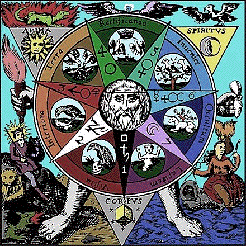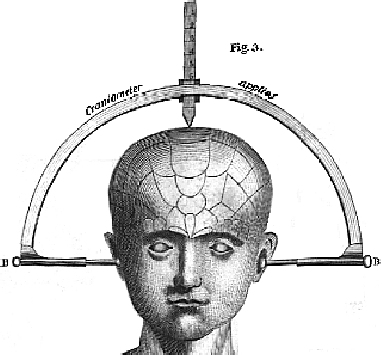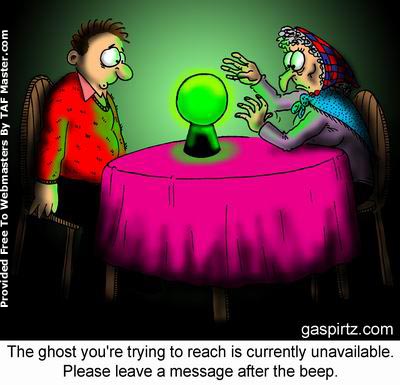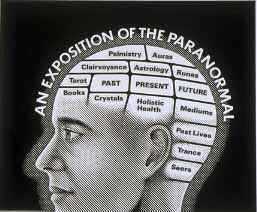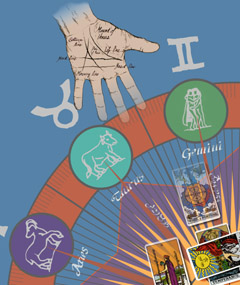
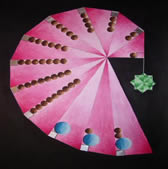 A pseudoscience is a belief or process which masquerades as science in an attempt to claim a legitimacy which it would not otherwise be able to achieve on its own terms; it is often known as fringe- or alternative science. The most important of its defects is usually the lack of the carefully controlled and thoughtfully interpreted experiments which provide the foundation of the natural sciences and which contribute to their advancement.
A pseudoscience is a belief or process which masquerades as science in an attempt to claim a legitimacy which it would not otherwise be able to achieve on its own terms; it is often known as fringe- or alternative science. The most important of its defects is usually the lack of the carefully controlled and thoughtfully interpreted experiments which provide the foundation of the natural sciences and which contribute to their advancement.
Above: Johathan Hope: Theodorus' Spiral (2003) - link
Of course, the pursuit of scientific knowledge usually involves elements of intuition and guesswork; experiments do not always test a theory adequately, and experimental results can be incorrectly interpreted or even wrong. In legitimate science, however, these problems tend to be self-correcting, if not by the original researchers themselves, then through the critical scrutiny of the greater scientific community. Critical thinking is an essential element of science.
Some other kinds of defective science
There have been several well-documented instances in which the correction process referred to above was delayed until after the initial incorrect interpretation became widely publicized, resulting in what has been called pathological science. The best known of these incidents are the "discoveries" of N-rays, of polywater, and of cold fusion. All of these could have been averted if the researchers had not been so enthused with their results that they publicized them before they had received proper review by others. Human nature being what it is, there is always some danger of this happening; to discourage it, most of the prestigious scientific journals will refuse to accept reports of noteworthy work that has already been made public.
Another term, junk science, is often used to describe scientific theories or data which, while perhaps legitimate in themselves, are believed to be mistakenly used to support an opposing position. There is usually an element of political or ideological bias in the use of the term. Thus the arguments in favor of limiting the use of fossil fuels in order to reduce global warming are often characterized as junk science by those who do not wish to see such restrictions imposed, and who claim that other factors may well be the cause of global warming. A wide variety of commercial advertising (ranging from hype to outright fraud) would also fall into this category; at its most egregious it might better be described as deceptive science.
"9944100% Pure: It Floats"
This description of Ivory Soap is a classic example of junk science from the 19th century. Not only is the term "pure" meaningless when applied to an undefined mixture such as bath soap, but the implication that its ability to float is evidence of this purity is deceptive. The low density is achieved by beating air bubbles into it, actually reducing the "purity" of the product and in a sense cheating the consumer.
Hoax science is another category that describes deliberately contrived sensationalist writings that have received wide publicity (and earned substantial royalties for their authors.) Immanual Velikovsky's Worlds in Collision (1950) is now probably the best known of these, followed by Erich von Däniken's Chariots of the Gods? (1968). Perhaps the most recent contender in this field is David Talbott, who with Wallace Thornhill wrote The Electric Universe and Thunderbolts of the Gods. A video of the latter can be seen here; it is very well done and will likely be quite convincing to those who have not had a year or two of college-level physics.
Fraudulant science and Scientific Misconduct refer to work that is intentionally fabricated or misrepresented for personal (recognition or career-advancement) or commercial (marketing or regulatory) reasons. Suppression of science for political reasons often occurred during the second Bush administration. The tobacco and pharmaceutical industries have been notoriously implicated in the latter category. (See below for some references)
The tobacco industry even published a phoney "scientific" journal containing articles written by hack authors that disputed warnings about smoking-induced cancer.
Charges of minor fudging go back to the days of Ptolemy, Gailileo, and Isaac Newton, but revelations of more contemporary frauds and their contamination of the scientific literature makes these far more problematic. Since about 1980, scientists at several major U.S. universities have been compelled to withdraw articles from prestigious journals. One of the most widely-publicised cases was that of the eminent Korean researcher who reported bogus stem cell results. Some rather troubling recent cases involve at least seventy articles describing bogus chemical structures reported by a group of scientists in China, and about an equal number of papers that had been forged or falsified by one or more scientists at a university in India.
 Finally, there is just plain bad science, which would logically encompass all of the evils being discussed here, but is commonly used to describe well-intentioned but incorrect, obsolete, incomplete, or over-simplified expositions of scientific ideas. An example would be the statement that electrons revolve in orbits around the atomic nucleus, a picture that was discredited in the 1920's, but is so much more vivid and easily grasped than the one that supplanted it that it shows no sign of dying out.
Finally, there is just plain bad science, which would logically encompass all of the evils being discussed here, but is commonly used to describe well-intentioned but incorrect, obsolete, incomplete, or over-simplified expositions of scientific ideas. An example would be the statement that electrons revolve in orbits around the atomic nucleus, a picture that was discredited in the 1920's, but is so much more vivid and easily grasped than the one that supplanted it that it shows no sign of dying out.
"It's only a theory"
In ordinary conversation, the word "theory" connotes an opinion, a conjecture, or a supposition. But in science, the term has a much more limited meaning. A scientific theory is an attempt to explain some aspect of the natural world in terms of empirical evidence and observation. It commonly draws upon established principles and knowledge with the aim of extending them in a logical and consistent way that enables one to make useful predictions. All scientific theories are tentative and subject to being tested and modified. As theories become more mature, they grow into more organized bodies of knowledge that enable us to understand and predict a wider range of phenomena. Examples of such theories are quantum theory, Einstein's theories of relativity, and evolution.
Scientific theories fall into two categories:
- Theories that have been shown to be incorrect, usually because they are not consistent with new observations;
- All other theories
In other words
- Theories cannot be proven to be correct; there is always the possibility that further observations will disprove the theory.
- A theory that cannot be refuted or falsified is not a scientific theory.
For example, the theories that underlie astrology (the doctrine that the positions of the stars can influence one's life) are not falsifiable because they, and the predictions that follow from them, are so vaguely stated that the failure of these predictions can always be "explained away" by assuming that various other influences were not taken into account. It is similarly impossible to falsify so-called "creation science" or "intelligent design" because one can simply evoke the "then a miracle occurs" (as in the famous Sidney Harris cartoon) at any desired stage.
How can you recognize pseudoscience?
How to rate a work of pseudoscience
is a 30-point checklist directed mainly at archaeology, but much of it seems applicable to other fields as well.
A similar set of questions can be found on this Baloney Detection page
There is no single test that unambiguously distinguishes between science and pseudoscience, but as the two diverge more and more from one another, certain differences become apparent, and these tend to be remarkably consistent across all fields of interest.
In examining the following table, it might be helpful to consider examples of astronomy vs. astrology, or of chemistry vs. alchemy, which at one time were single fields that gradually diverged into sciences and pseudosciences.
science |
pseudoscience |
comment |
| The primary goal of science is to achieve a more complete and more unified understanding of the physical world. | Pseudosciences are more likely to be driven by ideological, cultural, or commercial goals. | Some examples: astrology (from ancient Babylonian culture,) UFO-ology (popular culture and mistrust of government), Creation Science (attempt to justify a literal interpretation of the Bible), "structure-altered" waters (commercial quackery.) |
| Most scientific fields are the subjects of intense research which result in the continual expansion of knowledge in the discipline. | The field has evolved very little since it was first established. The small amount of research and experimentation that is carried out is generally done more to justify the belief than to extend it. | The search for new knowledge is the driving force behind the evolution of any scientific field. Nearly every new finding raises new questions that beg exploration. There is little evidence of this in the pseudosciences. |
| Workers in the field commonly seek out counterexamples or findings that appear to be inconsistent with accepted theories. | In the pseudosciences, a challenge to accepted dogma is often considered a hostile act if not heresy, and leads to bitter disputes or even schisms. | Sciences advance by accommodating themselves to change as new information is obtained.
In science, the person who shows that a generally accepted belief is wrong or incomplete is more likely to be considered a hero than a heretic. |
| Observations or data that are not consistent with current scientific understanding, once shown to be credible, generate intense interest among scientists and stimulate additional studies. | Observations or data that are not consistent with established beliefs tend to be ignored or actively suppressed. | Have you noticed how self-styled psychics always seem eager to announce their predictions for the new year, but never like to talk about how many of last years' predictions were correct? |
| Science is a process in which each principle must be tested in the crucible of experience and remains subject to being questioned or rejected at any time. | The major tenets and principles of the field are often not falsifiable, and are unlikely ever to be altered or shown to be wrong. | Enthusiasts incorrectly take the logical impossibility of disproving a pseudoscientific priniciple as evidence of its validity. |
| Scientific ideas and concepts must stand or fall on their own merits, based on existing knowledge and on evidence. | Pseudoscientific concepts tend to be shaped by individual egos and personalities, almost always by individuals who are not in contact with mainstream science. They often invoke authority (a famous name, for example) for support. | Have you ever noticed how proponents of pseudoscientific ideas are more likely to list all of the degrees they have? |
| Scientific explanations must be stated in clear, unambiguous terms. | Pseudoscientific explanations tend to be vague and ambiguous, often invoking scientific terms in dubious contexts. | Phrases such as "energy vibrations" or "subtle energy fields" may sound impressive, but they are essentially meaningless. |

Why is it important to recognize pseudoscience?
Many scientists' ordinary response to pseudoscientific claims is simply to laugh at them. But mythology has always been an important part of human culture, often by giving people the illusion of having some direct control over their lives. This can lead to their becoming advocates for various kinds of health quackery, to commercial scams, and to cult-like organizations such as scientology. Worst of all, they can pressure political and educational circles to adopt their ideologies.
A good summary of some of the consequences can be found in Prof. Steven Dutch's article When the Cranks Rule.
Does the "establishment" actively suppress new and unconventional ideas?
Anyone who has been around for long enough has encountered statements like these:
- An inventor's design for a device that utilizes water as a fuel has been bought up and suppressed by the oil companies.
- "Alternative health" techniques (homeopathy, chiropractic, chelation therapy— you name it!) are actively suppressed by the medical profession or the pharmaceutical industry in a desperate attempt to serve their selfish interests.
- Reports of unidentified flying objects (UFO's) are suppressed by the U.S. Government in an attempt to prevent panic and/or to maintain control over citizens.
- Editors of scientific journals and the reviewers they call on to assess the worth of submitted papers reject out-of-hand anything that comes from persons who are not members of the scientific "establishment" or which report results not consistent with presently-accepted science.
Claims of these kinds are frequently made and widely believed, especially by those who are inclined to see conspiracies around every corner. There is little if any evidence for any of these claims. The real reason that new devices or new theories get thrown aside is that the arguments or evidence adduced to support them is inadequate or not credible. The individuals who believe themselves to be unfairly thwarted by the scientific community are very often so isolated from it that they are unable to appreciate its norms of clarity, rigor, and consistency with existing science.
... but they laughed at Galileo, at Thompson, and at Wegner.
Well, with Galileo, they didn't exactly laugh; it was more a case of challenge to religious doctrine that forced him to recant his assertion that the Sun, and not the Earth, is at the center of the solar system. There have been innumerable cases in which the world was simply not ready to accept a new idea. This was especially common before the scientific method had been developed, and before the technology needed to apply it had become available.
When J.J. Thomson discovered evidence that the atom is not the ultimate fundamental particle and could be broken up into smaller units, even Thomson himself was reluctant to accept it, and he became a laughingstock for several years until more definitive evidence became available.
Alfred Wegener's theory of continental drift was bitterly attacked when it was first published in 1915, and it did not become generally accepted until about 50 years later. Others had made similar proposals based on the way the continents of Africa and South America could be fitted together, but Wegener was the first to make a careful study of fossil and geological similarities between the two continents. Nevertheless, the idea that continents could float around was too hard to accept at a time when nothing was known about the interior structure of the Earth, and the evidence he presented was rejected as inadequate.
But even in more recent times, the world of science has been reluctant to accept some important challenges made by its own members; see this National Center for Science Education page that profiles the difficulties faced by scientists such as Barbara McClintock (genetic recombination), Lyn Margulis (endosymbiosis and evolution), and Barry Marshall (bacterial origin of ulcers).
On the other hand, the even-more-revolutionary concepts of special- and general relativity, and of quantum theory (which developed in several stages), achieved rapid acceptance when they were first presented, as did Louis Pasteur's germ theory of disease. In all of these cases the new theories provided credible explanations for what was previously unexplainable, and the tools for confirming them existed at the time, or in the case of general relativity, would soon become available.
Some interesting places to look
"It's been my policy to view the Internet not as an 'information highway,' but as an electronic asylum filled with babbling loonies." —Mike Royko |
This quote from the late columnist was found at Donald Simanek's site -- a wonderful collection of links that contains many references to science fraud, pseudoscience, fringe medicine, perpetual motion, and generally weird ideas.
Some useful tools
What is truth? Not a simple question to answer, but this excellent page at the Internet Encyclopedia of Philosophy will help show you the way.
Critical Thinking A compilation of Web-based resources on the subject.
Pseudoscience and Quackery SWICKI search
Bad ScienceBad Science page by UK's Dr. Ben Goldacre "What the Bleep Do We Know?" - a review of this popular and highly misleading 2004 film. Bad-science examples in the various disciplines (Alistair Fraser) How to deal with bad- and questionable science is the topic of this anonymous essay. Ten myths of science: Reexamining what we think we know. Fraudulant Science, Scientific MisconductScientific fraud and the power structure of science (Brian Martin, Promethous 10(1) 1992) The Science Police (The David Baltimore case) - (NY Times Books 20 Sept 1998) Betrayers Of The Truth: Fraud and deceit in the Halls of Science (William Broad and Nicholas Wade, 1982) A rather controversial book. Amazon review - Authors' reply to an unfavorable review - scathing review by chemist Henry Bauer Junk ScienceBending Science: How Special Interests Corrupt Public Health Research (Thomas McGarity, Wendy Wagner - Harvard U Press, 2008) Reviews: ChemHeritage - NIH Doubt is Their Product: How Industry's Assult on Science Threatens Your Health - this 2008 book by David Michaels provides a glimpse of tactics used by industry to manipulate science and influence public policy. Just as the tobacco industry did in the 1950's, the idea is to cast doubt on scientific studies that threaten their products. More details in this New Scientist review. JunkScience.com: "All the junk that's fit to debunk" - and you will find it in abundance here— unfortunately, compounded by what many would consider a bias not atypical of the author's affiliation with the Cato Institute and FoxNews. This site can nevertheless serve as a source of student exercises on the fine art of critical thinking. Junk science in the courtroom - a compendium of horrendous examples AquaScams - my site on commercial water-related pseudoscience (magnetic water treatment, etc.) and quackery ("Clustered" and "Ionized" waters) Medical pseudoscience, fringe medicineQuackWatch - a good source for solid information on medical flim-flam such as amalgam dental filling removal, etc. Canadian Quackery Watch - many good articles on alternative health scams HealthWatcher - a well organized anti-health-scam site maintained by a Canadian doctor Science-based Medicine exlores issues and controversies in the relationship between science and medicine. Homeopathy - This Wikipedia article presents a good overview and thorough history with many references; the HomeoWatch site is more critical. In 2010, a UK parliamentry committee report urged the government to withdraw funding and licensing of homeopathy. 2009 commentary on Montagnier article "proof" of homeopathy. See also this interesting article from The Quackometer site: The Curious Case of Oxford University Press, Homeopathy and Charles Darwin, Water Cluster Quackery - my page on bogus "structure-altered waters" for the alternative health market. Of course, even Pasteur is not immune to Web-based rants such as this one which attempts to refute the Germ Theory of disease! Pathological scienceNicholas Turro's page has a fine discussion of this topic with many references. PseudoscienceList of Pseudosciences - this useful resource provides quick summaries as well as in-depth links to all the major (and many of the minor) pseudosciences. (MediaWiki)
This pseudoscience page by Edward Lipson offers a well-organized wealth of links on many areas of pseudoscience. Putting Pseudoscience to work. See Using bad science to teach good chemistry by Michael Epstein, J.Chem.Ed. 1998: 75(11) 1399-1404. Alchemy? It died at the end of the 17th century, but the Internet loonies have resurrected it with courses, conventions, and endless discussions: see here for an example. Fringe Archaeology - Keith Matthews' Cult Archaeology site covers everything from von Däniken to lost continents The Scientific Exploration of Astrology contains links to variety of critical articles on astrology, its history, psychology, and tests of its validity. Jim Loy's Peudoscience Page - nicely organized by topic and sub-topic. Science Hoaxes - A Guardian article on the Piltdown Man fraud and other hoaxes Brian Dunning's excellent Skeptoid site offers weekly takes pseudoscientific topics in both text and podcast formats. Pseudoscience books Henry Bauer's book Science or Pseudoscience: Magnetic Healing, Psychic Phenomena, and Other Heterodoxies is described (and can be purchased) at this U. Illinois Press site.
This review of Voodoo Science: The Road from Foolishness to Fraud by Robert L. Park (Oxford U. P., New York, 2000) from Physics Today. Skepticism and debunkingThe Skeptic's Dictionary: A Critical Survey of Questionable Therapies, Eccentric Beliefs, Amusing Deceptions and Dangerous Delusions. This excellent site by a professor of philosophy at Sacramento City College contains hundreds of skeptical definitions and essays on occult, paranormal, supernatural and pseudoscientific ideas and practices with references to the best skeptical literature. Translations into several other languages are available. Skeptical information links - a well-organized collection of links by Jim Lippard. Dowsing for dollars: some thoughts on B.S. detection Dr. Stephen Barrett on what makes people vulnerable to quackery The Science of Scams - a collection of short video clips on various aspects of pseudoscience and belief.
MagazinesThe following two magazines are of general interest and fun to read; one or both should be on the subscription list of any school library. Both sites provide searchable links to past articles. Skeptic - published by the Skeptics' Society Skeptical Inquirer "The magazine for science and reason", published by CSICOP. WeirdThe Anders Mad Scientist page is not easy to classify, but the many link titles seem to cover just about every form of pseudoscientific weirdness. |
--
craniometer
racial pseudoscience
Illustration by Ted Chesky [link]
Quilt art by Barbara Olson: Atlantis: an ancient message [link]
"Put a pair of earphones around your mixed gallon of clustered distilled water and play the CD .. delivering the healing frequencies back to the solution." [link] |
Pseudoscience in the news
Climate Denial in the Classroom (LA Times, 20 Feb 2012)
US judges rule for teacher who called creationism 'superstitious nonsense' (CSM, Warren Richey, 19 Aug 2011)
UK's loose libel laws stifle science:
- Simon Singh and the silencing of scientists (Guardian, 25 Feb 2010)
- Silencing Justice: The government must stop allowing England's libel courts to be used by the rich and powerful to stifle free speech (ProgressOnline, Feb 2010)
- Britain, Long a Libel Mecca, Reviews Laws (Sarah Lyall, NYT 10 Dec 2009)
- BCA drops libel action against Simon Singh (Guardian, 15 April 2010)
UFO Watchtower in Hooper, Colorado (NYT 25 Nov 2010)
Far Out, Man. But Is It Quantum Physics? (Dennis Overbye, NYT 14 Mar 2006) - thoughts on What the Bleep, Down the Rabbit Hole
Evolution debate spawns a saucy monster The theory that a "Flying Spaghetti Monster" created the world is demanding equal time along with Intelligent Design in Kansas biology classrooms.
New study says homeopathic medicines don't work (Jeremy Lovell, Reuters) The investigators conclude that the clinical effects of homoeopathy are compatible with placebo effects.
Leading Cardinal Redefines Church's View on Evolution (Cornelia Dean, Laurie Goodstein, NY Times 9 July 2005) An influential cardinal in the Roman Catholic Church, which has long been regarded as an ally of the theory of evolution, is now suggesting that belief in evolution as accepted by science today may be incompatible with Catholic faith
Evolution Takes a Back Seat in U.S. Classes (Cornelia Dean, New York Times 1 Feb. 2005). In districts around the country, even when evolution is in the curriculum it may not be in the classroom. Teaching guides and textbooks may meet the approval of biologists, but superintendents or principals discourage teachers from discussing it. Or teachers themselves avoid the topic, fearing protests from fundamentalists in their communities.
Odds Are Stacked When Science Tries to Debate Pseudoscience (Lawrence Kraus, New York Times 30 April 2002) Opponents of the scientific method try very hard to appear in debates with scientists. Merely being on the same stage represents a victory.
Believe it or not (Nicholas D. Kristof, New York Times 15 August 2003) - The increasing willingnness of Americans to put faith ahead of science represents a growing divide from the rest of the world.
The Seven Warning Signs of Bogus Science (San Francisco Chronicle) The National Aeronautics and Space Administration is investing close to a million dollars in an obscure Russian scientist's antigravity machine, although it has failed every test and would violate the most fundamental laws of nature. The Patent and Trademark Office recently issued Patent 6,362,718 for a physically impossible motionless electromagnetic generator, which is supposed to snatch free energy from a vacuum. And major power companies have sunk tens of millions of dollars into a scheme to produce energy by putting hydrogen atoms into a state below their ground state.
x

